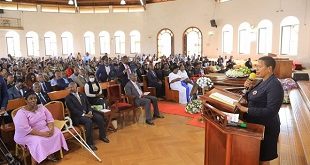
Non-performing loans more than doubles to 7.7 %, Crane Bank sinks
As 2016 comes to an end, it is clear that it has been a year in which the banking industry choked on surging losses on the back of bad loans. One of the biggest banks; Crane Bank, suffered a capital wipe-out and the central bank took over its management. However, when The Independent listened to several top managers in the banking sector recently, it became clear that although they quote similar numbers, some view them differently.
Take Emmanuel Tumusiime-Mutebile, the man who, as governor for the Bank of Uganda (BoU) for the last 16 years, has seen a fair share of tough years in the sector. He sounded in awe of 2016.
“We cannot deny that it has been a difficult year for the banking industry with very low asset growth, a sharp deterioration in asset quality and a decline in returns on equity,” he told bankers on Nov.25 during their annual dinner in Kampala.
But Mutebile also appeared determined to keep sentiments under control. For example, although he said the key challenge was the rise in Non-Performing Loans (NPLs), he quoted lower numbers. He said NPLs swung from 3.8% of the total loans of commercial banks in September 2015 to 7.7 % in September 2016.
He also said that over the year to September 2016, commercial banks had to make provisions of Shs 345 billion for NPLs, which is double the amount, set aside in the previous 12 months.
These provisions, according to Mutebile squeezed profits, with average after tax returns on equity falling to 14.9% in the 12 months to September 2016 compared to 17.1% in the previous 12 months.
But Patrick Mweheire, the chief executive officer of Stanbic Bank; which is Uganda’s largest bank by total assets, cites slightly higher figures. Mweheire also says the sector felt the pinch of a high interest rate environment creep.
He said 2016 was a difficult year mainly because “credit growth was essentially flat year-on-year”. On Non-Performing Loans (NPL) he said they hit the 8-9% zone. That is almost two percentage points or 30% estimation higher than Mutebile’s numbers – and sentiment.
“I believe NPL’s are above Shs 900 billion at the moment for an industry that barely makes Shs 500 billion in profits per year. That is a concern.”
That difference in inflection on the numbers is significant as it mirrors the gap in perception of the severity of crisis in the banking sector and the greater economy between the bureaucrats at Bank of Uganda and the trade floor operators.
Mweheire, for example, said credit growth slowed in 2016 and affected commercial banks’ ability to grow their loans and advances.
He said that the GDP growth rate of 4.6% was simply not robust enough for the real economy to make major investments and that alone exacerbated to less industry profitability.
He added that the effects of South Sudan also came into play as several businesses lost 20%-30% of their revenues which was being exported.
Mweheire said NPLs were at the top of the cycle and this was to be expected because of a tightening monetary policy by BoU that increased the key policy lending rate –the central bank rate – five times. The policy rate increase led to increase in prime rates across the industry and affected affordability of loans.
But Mutebile is defensive. “The squeeze on bank profitability would have been much worse were it not for the fact that banks widened their net interest margins,” he said. “The high interest rates which prevailed over the course of most of the last 12 months helped banks to recoup some of the losses they suffered as a result of bad debts.”
 The Independent Uganda: You get the Truth we Pay the Price
The Independent Uganda: You get the Truth we Pay the Price


